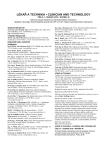DESIGN CONCEPTS FOR PREVENTING GAS BUBBLE INTERFERENCE IN MICROFLUIDIC DEVICES
Unintendedly introduced gas bubbles in channels can significantly interfere with performance and behavior of microfluidic systems. Thus, there is a high demand for smart microfluidic system designs which are capable of preventing gas bubbles. In this work, we develop two different bubble interference preventing system designs: a degasser device that actively removes gas bubbles from the liquid based on pressure driven gas permeation, and a passive micro channel design that provides a guiding mechanism based on the gas bubbles’ effort to minimize their surface energy. The effective performances of the devices are demonstrated.
Keywords:
microfluidics, gas bubble removal, degassing
Autoři:
Sebastian Richert; Oliver Peters; Vu Hoa Nguyen; Uwe Schnakenberg
Působiště autorů:
Institute of Materials in Electrical Engineering 1, RWTH Aachen University, Germany
Vyšlo v časopise:
Lékař a technika - Clinician and Technology No. 2, 2016, 46, 41-45
Kategorie:
Původní práce
Souhrn
Unintendedly introduced gas bubbles in channels can significantly interfere with performance and behavior of microfluidic systems. Thus, there is a high demand for smart microfluidic system designs which are capable of preventing gas bubbles. In this work, we develop two different bubble interference preventing system designs: a degasser device that actively removes gas bubbles from the liquid based on pressure driven gas permeation, and a passive micro channel design that provides a guiding mechanism based on the gas bubbles’ effort to minimize their surface energy. The effective performances of the devices are demonstrated.
Keywords:
microfluidics, gas bubble removal, degassing
Zdroje
[1] Skelley, M. A., Voldman, J., An active, integrated bubble trap and debubbler for microfluidic applications, 12th International conference on miniaturized systems for chemistry and life sciences, San Diego, CA, USA. 2008, p. 1360-1362.
[2] Lochovsky, C., Yasotharan, S., Guenther, A., Bubbles no more: in-plane trapping and removal of bubbles in microfluidic devices, Lab on a Chip, 2012, vol. 12, no. 3, p. 595-601.
[3] Lötter, J.C., Olthius, W., Veltink, P.H., Bergveld, P., The mechanical properties of the rubber elastic polymer poly-dimethysiloxane for sensor applications. Journal of Micromechanics and Microengineering, 1997, vol. 7, p. 145-147.
[4] Jo, B.-H., Van Lerberghe, L. M., Motsegood, K. M., Beebe, D. J., Three-dimensional micro-channel fabrication in poly-dimethylsiloxane (PDMS) elastomer. Journal of Microelectromechanical Systems, 2000, vol. 9, no.1, p. 76-81.
[5] Merkel, T.C., Bondar, V.I., Nagai, K., Freeman, B.D., Pinnau, I., Gas sorption, diffusion, and permeation in poly(dimethyl-siloxane), Polymer Physics, 2000, vol. 38, no. 3.
[6] Baroud, C.N., Gallaire, F., Dangla, R., Dynamics of microfluidic droplets. Lab on a chip, 2010, vol. 10, p. 2032-2045.
[7] Guenther, A., Manish, J., Thalmann, M., Schmidt, A.M., Jensen, K.F., Micromixing of miscible liquids in segmented gas-liquid flow. Langmuir, 2005, vol. 21, no. 4, p. 1547-1555.
Štítky
BiomedicínaČlánok vyšiel v časopise
Lékař a technika

2016 Číslo 2
Najčítanejšie v tomto čísle
- EARLY DISCHARGE (48–72 HOURS) AFTER ACUTE ST-SEGMENT ELEVATION MYOCARDIAL INFARCTION: INTERIM RESULTS OF THE OPEN, RANDOMIZED, MONOCENTRIC STUDY
- CELL-BASED SENSOR CHIP FOR NEUROTOXICITY MEASUREMENTS IN DRINKING WATER
- TESTING A SYSTEM FOR PREDICTING MICROSLEEP
- DESIGN CONCEPTS FOR PREVENTING GAS BUBBLE INTERFERENCE IN MICROFLUIDIC DEVICES
